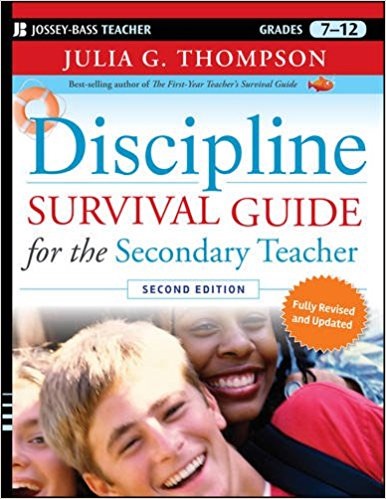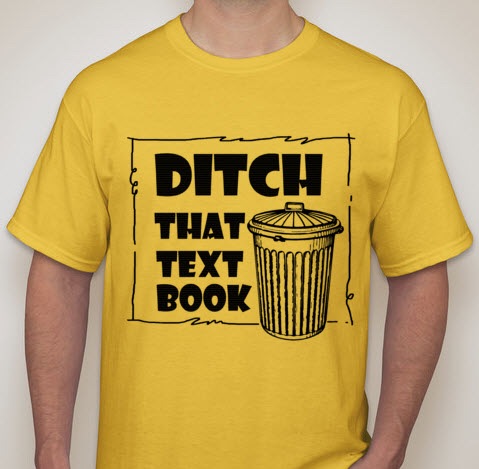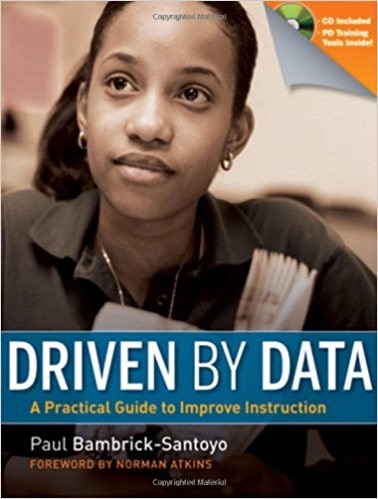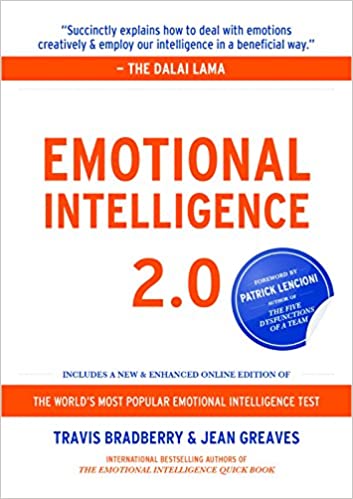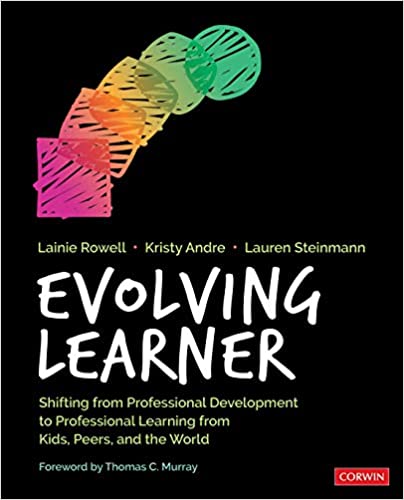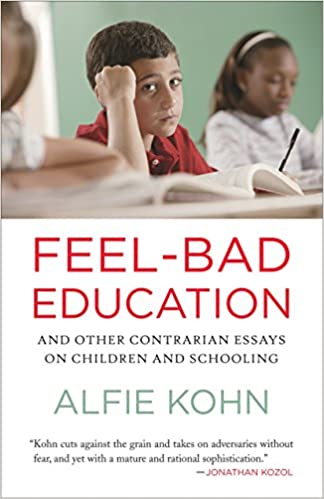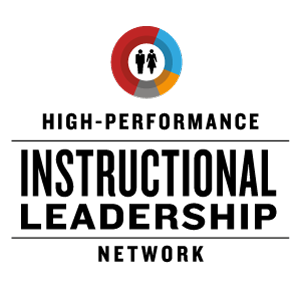Archive for the ‘Education Books’ Category
Thursday, August 25th, 2011
Discipline Survival Guide for the Secondary Teacher, 2nd Ed, (©2011, Jossey-Bass: San Francisco, CA) Julia Thompson takes on what may be the most unpleasant part of the profession and a top reason why teachers leave. She draws on up-to-date research and theory that can help students become more self-disciplined, goal-oriented, and successful learners as teachers enhance leadership skills. She focuses on student motivation, classroom management, relationships, instructional techniques, safety, and high expectations. This 350-page effort is easy to read and can be used as a desktop reference. My summary contains key ideas, but there is a lot more I left out. Every student teacher, beginning teacher, and veteran teacher with discipline problems should have this at their side. Lots of advice for parents too. As a former secondary teacher and elementary principal, I can assure you most of this applies to students of all ages.
Successful Discipline Rests With You
- It is important to take responsibility for what happens in class and to not dwell on who to blame for bad behavior. Outdated practices won’t work with modern students. Class activities should allow students to be active and involved, and let students help each other. Vary the action during a class. Ideally, you will challenge students with things they can attain. Work with students to set goals, watch for signs of trouble before it starts, and work with parents. Use questionnaires to gather interests and opinions and bring in popular culture and real-world connections when possible. Don’t hesitate to allow students to discuss their concerns and adjust your attitude to see them as joyful and vigorous rather than annoying. Be positive rather than cranky and critical. Overreacting only makes things worse. Be respectful rather than confrontational. Be sure to listen. Avoid sarcasm and present yourself as a confident leader. Give positive attention before students seek negative attention. A positive caring attitude is essential.
Take a Comprehensive Approach
- You need to take a broad view and use a variety of methods as the job of discipline is very complex. Do what you can to make the room inviting and use the walls for student work. Work hard on getting to know each student and let them know what you expect. Prepare innovative lessons and have everything ready. Lessons should allow students to be active and usually talk more than the teacher. Focus students on being responsible for their own learning and avoid threats. A class should be a functioning community. You must manage your own stress. If students are agitated take a moment to think and stay cool. Thompson includes a list of common mistakes and ways to avoid them, a teacher self-assessment, a worksheet to develop your plan, and a section on how to put your expectations to work.
Tags: Discipline, Discipline Survival Guide, Julia G. Thompson
Posted in Book Summaries, Education Books, Leadership Books | Comments Off on Discipline Survival Guide for the Secondary Teacher – by Julia Thompson
Tuesday, April 5th, 2016
The genesis of Matt’s DITCH model of teaching starts in 2007 when he was lecturing and teaching from a textbook. He knew the kids were bored and so was he. He was stuck in the old paradigm of using the textbook as the curriculum along with worksheets and multiple choice tests. While I’m always leery of words as acronyms as their authors usually have to stretch things a bit to make them work, the DITCH acronym really works. It stands for Different, Innovative, Tech-Laden, Creative, and Hands-On. These are the hallmarks of Matt’s model that he rolls out in this book. In addition to ditching your textbook, this model also requires you to ditch your curriculum and, perhaps more importantly, ditch your mindset.
Before and After
- Imagine it’s 1904 and you want to have a conversation with the legendary John Dewey who lives in Chicago? Unless you lived nearby, this would be essentially impossible. Today, however, it is possible to have conversations or at least listen to famous educators from all over the world thanks to the Internet.
- If you started teaching when I did, you were probably were much less efficient that connected teachers today who have electronic filing cabinets and many other time saving applications. Today you can take your students on electronic field trips at little or no cost. Things you write don’t rely on good penmanship. Finding information seldom take more than a few seconds. In short, going digital makes your life and your students’ lives much easier.
Posted in Book Summaries, Education Books, Leadership Books | Comments Off on Ditch That Textbook by Matt Miller
Friday, October 12th, 2012
Do You Know Enough About Me to Teach Me? A Student’s Perspective by Stephen G. Peters (©2006, The Peters Group Foundation: Orangeburg, SC.) provides insight from students he gathered during extensive interviews and uses this perspective to let teachers know what they may have missed in college. His goal is to help teachers learn how to care for all students by listening with all their hearts to the voices of students. Click the icon at the bottom of any page to purchase this fine book.
Stephen G. Peters
- Stephen has been an educator for more than 25 years with experience as a teacher, assistant principal, principal, and director of secondary education. He is founder of The Gentleman’s Club, a program that seeks to change attitudes and behaviors of at-risk and borderline males and The Ladies Club that aims to empower girls to be their own best friends and inspire them to discover and be proud of who they are. He is also a partner at CasseNEX, a leader in online course design and delivery. For more on his work check his website.
It’s All About Relationships
- Stephen believes that the solutions to many education problems reside within the hearts and minds of the students themselves and that we all lose when we silence or ignore their voices. It’s the special relationships between students, teachers, and administrators that are the keys that unlock the door to success and excellence in any school. Part 1 features interview transcripts from four selected students.
Keisha
- Most students want to learn. We have a whole lot to deal with outside of school and we need respect, structure, and consistency. Her favorite teacher told the class on the first day that they all had A’s and that motivated her to work to keep it. It was her first A. As a 9th grader she finds that many teachers don’t seem to care. The best teachers treat you with respect and work hard to make lessons interesting.
Marvin
- Marvin’s favorite teacher told him he was smarter than he thought he was and made learning relevant and meaningful. She was a master at forming positive relationships with her students and never wrote discipline referrals. The other key influence in Marvin’s life was his coach. The relationship was so strong that the coach felt like a family member and Marvin worked hard to meet the coaches expectations. He was impressed when one teacher showed up at one of his football games. That made him want to work to pass her course. He also appreciates teachers who stay late to help kids and go out of their way to do unexpected acts of kindness. He doesn’t like the administrators as he has the sense that they don’t like him.
Posted in Book Summaries, Education Books | Comments Off on Do You Know Enough About Me to Teach Me? A Student’s Perspective by Stephen G. Peters
Wednesday, August 18th, 2021
Drive: The Surprising Truth About What Motivates Us by Daniel Pink is a must-read for educators and parents alike. Dan summarizes current research and does a great job turning it into interesting and understandable prose that educators can apply to their practice. Every school should have this on the shelf.
Three Types of Motivation
- 1.0 – The basic motivations we need for survival
- 2.0 – Motivations based on direct rewards and punishments. Such carrots and sticks are typically financial in this context. They work for jobs that are routine, which are often the jobs that can be sent offshore or done by a computer.
- 3.0 – Intrinsic motivation, which is conducive to creativity. This allows you to do things for the satisfaction of doing them rather than any monetary reward. Examples include open source software, Wikipedia, learning to play a musical instrument, or doing a puzzle. It is important for nonroutine (heuristic) jobs. In these jobs rules are loosely defined, which requires creativity.
Carrots and Sticks Don’t Always Work
- Pink sites 128 studies that lead to the conclusion that tangible rewards tend to have a substantially negative effect on intrinsic motivation. This is one of the most robust findings in social science and one of the most ignored. (Doug: Educators should check out Alfie Khon’s 1993 book, Punished by Rewards.)
- Studies show that rewards and punishments can extinguish motivation and diminish performance. They focus behavior, which can crush creativity and they can crowd out good behavior. In some cases, they can lead to cheating, shortcuts, unethical behavior and lead to addiction. They can foster short-term thinking at the cost of long-term results.
Carrots and Sticks Aren’t All Bad
- Rewards do not undermine people’s intrinsic motivation for dull tasks where there isn’t any motivation to be undermined. To increase chances for success you need to: 1) Offer a rationale for why the task is important 2) Acknowledge that the task is boring 3) Allow people to complete the task their own way. Another way to offer extrinsic rewards for creative work is to give the reward after the job is finished. Care must be taken so that such rewards don’t become expected. In general, praise and specific positive feedback are less corrosive than cash and trophies (Doug: That means stickers for you elementary teachers)
Tags: Daniel Pink, Drive, Motivation
Posted in Book Summaries, Business Books, Education Books, Leadership Books | Comments Off on Drive: The Surprising Truth About What Motivates Us by Daniel Pink – Updated Summary
Thursday, August 21st, 2014
Driven by Data: A Practical Guide to Improve Instruction by Paul Bambrick-Santoyo offers a step by step approach to preparing your students for high-stakes tests while students work to master standards. While you may be hoping for the current testing madness to end, Paul offers a practical way for your school to out perform other schools with similar demographics while the current tests are still with us. Part two includes specific workshop activities for data leaders.
Paul Bambrick-Santoyo
- Paul is managing director of Uncommon Schools, leading six schools in the North Star Academy network that have achieved some of the highest results in the country. He has trained over 2,000 school leaders nationwide, and is the Data-Driven Instruction faculty member for New Leaders for New Schools, an urban school leadership training program.
Physicals or Autopsies?
- Paul likens the analysis of end-of-year and high-stakes state testing to an autopsy where the purpose is to find out why the patient died. He prefers that educators spend their time looking at the results of interim tests and use them to inform instruction. This is similar to how a physician would use the results of a physical to determine treatment and recommend lifestyle changes. Paul also warns that data-driven instruction is not an elaborate stratagem for promoting “test prep.” While he sees many faults in the NCLB testing culture, he is happy to see educators focusing more on accountability for student achievement, and interim assessments hold them accountable throughout the year.
Excellent Interim Assessments
- In order to be effective, interim assessments must be of high quality, which is seldom what you get when individual teachers slap something together at the end of a unit. The tests need to be in place prior to the start of the school year and be available to the teachers. Every teacher at the same grade level or subject should be using the same tests at the same time. This allows teachers to analyze the results together. Paul recommends assessments every six to eight weeks. Too seldom allows weaknesses to go unrecognized. Too often and teachers may not have time for satisfactory analysis. It is also important that teachers be involved in test creation or selection. Paul is ok with purchased tests as long a teachers get to see them. Some vendors don’t allow this in order to maintain test validity.
- The tests are not seen as an end, but as a beginning. This is because they let the teachers know what needs to be taught and the desired level of rigor. When they are given, the results need to be available soon. (Doug: When I taught I always graded assessments the day they were given, and the students got the results as part of the next class. With some kinds of computerized testing, students can see their results immediately.)
Posted in Book Summaries, Education Books, Leadership Books | Comments Off on Driven by Data: A Practical Guide to Improve Instruction by Paul Bambrick-Santoyo
Monday, June 8th, 2020
Emotional Intelligence 2.0 by Travis Bradberry & Jean Greaves (the book can be found succinctly explains how to deal with emotions creatively and how to employ your intelligence in a beneficial way. There is strong evidence that EQ can be improved with effort and this book can direct that. Higher EQ leads to success on the job and at home so this is a book that everyone can use to forge a better life.
1. The Journey
- All information from your senses has to pass through the emotional part of your brain (the limbic system) before it gets to the rational or thinking part of your brain (the frontal cortex). It’s the communication between your emotional and rational brains that is the physical source of emotional intelligence or EQ. It is emotional intelligence that explains why people with high IQs don’t consistently outperform people with average IQs.
- The purpose of this book is to help you increase your EQ. You start by taking the Emotional Intelligence Apprasal online. To see your scores you will need the code at the end of the book, which is only good for one person. This appraisal provides a baseline against which you can judge your improvement. This is a new feature in version 2.0. You can also retake the test after you finish the book to see how much you have learned.
2. The Big Picture
- Emotional awareness and understanding are not taught in school, but self-knowledge and emotional mastery are required to make good decisions on the job and in life. We have many words to describe our feelings yet all emotions are derivations of five core feelings: happiness, sadness, anger, fear, and shame. Here we find twenty different words to describe each. When emotions are intense they can highjack your rational thinking and cause you to react reflexively. Your reaction to these trigger events is shaped by your personal history. Enhanced EQ can help you recognize triggers and let you respond in a rational manner.
- We all possess the qualities of personality, EQ, and IQ. Of the three, EQ is the one most amenable to improvement. It is also the foundation of a host of critical skills like time management, decision-making, and communications. It is the strongest driver of leadership and personal excellence. It is highly correlated with high-performance and salary regardless of the job. The rest of the book will help you improve your EQ.
3. What Emotional Intelligence Looks Like: Understanding the Four Skills
- The four EQ skills come in two pairs known as personal competencies and social competencies. The first includes self-awareness and self-management. This is where you stay aware of your emotions and manage the resulting behavior and tendencies. Social competencies include social awareness and relationship management. This is where you work to understand other people’s mood, behavior, and motives. Emotions always have a purpose as they shape your reactions to the world around you.
- Self-awareness is a foundational skill; when you have it the other skills will be easier to use. Self-management is dependent on your self-awareness as it gives you information that you can act on rationally rather than reflexively. Social awareness is also foundational as you need to pick up on the emotions of others so you can better manage your relationships. You need to listen well rather than thinking about what you are going to say next when another person stops talking. Relationships require you to understand others and are based on how you treat them over time. This chapter also contains positive and negative examples of all four skills.
Posted in Book Summaries, Business Books, Education Books, Leadership Books | Comments Off on Emotional Intelligence 2.0 by Travis Bradberry & Jean Greaves (the book can be found here)
Monday, August 31st, 2020
Evolving Learner: Shifting from Professional Development to Professional Learning From Kids, Peers, and the World (©2020) by Lainie Rowell, Kristy Andre, and Lauren Steinmann focuses on how teachers need to learn from their students, their peers, and the world at large. They also need to be allowed to have a voice and choice when it comes to their professional learning rather than be exposed to old school one-size-fits-all professional development.
Introduction
- The main idea is to move from traditional one-size-fits-all seat time professional development to innovative learner-driven personalized deliverables. An organization called Learning Forward developed Standards for Professional Learning and this book is a practitioner’s guide to mastering them. As you learn there are things that you have to unlearn, which is difficult. You also have to change your role from expert to learner and to not fear failure. Andragogy deals with the methods or techniques used to teach adults. 1. Adults should be involved in the planning and evaluation of their instruction. 2. Experience, which includes mistakes, provides the basis for learning activities. 3. Subjects should have immediate relevance and impact on their job or personal life. 4. Adult learning should be problem-centered rather than content-oriented.
- While there are many cycles of inquiry with similarities and differences, the authors decided to create their own. Their essential pieces are Focus, Learn, Refine, and Reflect. This cycle is revisited throughout the book. This book is about relationships for learning through a cycle of inquiry. Teachers who have experienced online and blended learning have higher aspirations for leveraging technology. With technology, it is much easier to differentiate learning. Social-emotional learning should also be integrated rather than separated from any learning.
1. Learning from Kids: Honor the Learner
- We need to shift from teacher-driven to learner-driven and by learner, we mean kids and adults. While students are engaged in the learning cycle of focus, learn, refine, and reflect based on content, teachers are engaged in this same cycle regarding their practice. Students should be seen as clientele. (Doug: I prefer customers.) Teachers need to respect each student’s ideas, experiences, and perspectives in order to serve them better. In other words, they need to constantly learn from the students.
Leveraging the Most Abundant Resource in Our Schools
- Students are the most underutilized resource in a classroom. They are critical to personalized learning for teachers. To learn from kids probably requires a change in mindset for most teachers. One survey of middle school students that asked “how do you feel in school each day” gave the top three responses as tired, bored, and stressed. The authors think that this may be because they don’t feel seen and heard. Making learning truly reciprocal may solve this problem. There an extended response here from Adora Svitak. She gave a TED Talk at the age of twelve on the topic of what adults can learn from kids that now has over five million views The response here was given when she was twenty.
What Are They Thinking? Making THinking Transparent to Tailor Instruction and Promote Teacher Inquiry
- Thanks to tech tools it’s possible for a teacher to ask a question and see everyone’s answer. This can greatly aid the ability to do formative assessments. Without such tools, you are likely to get the same kids answering all of the questions. When using these tools be sure to put lesson design first and not the tool. This approach will also give students more processing time as it lets the teacher assess prior knowledge.
- As students go through the grades they ask fewer questions. One way to fight this is to use the 5E’s approach. Here we start with Engaging students by asking an open-ended question. You can use a Word Cloud tool to create an illustration that students can use to Explore the topic further. The Explain part of the lesson can address unanswered questions. Further Elaboration comes next followed by Evaluation. Since learning is messy don’t be surprised if you move back and forth between these steps.
- Next the focus in on students formulating questions. First, the teacher comes up with a question focus contained in the curriculum. Students then independently produce questions without initial judgment of a question’s quality. They prioritize closed-ended and open-ended questions, plan the next steps, and reflect. Questions can even be used as part of assessments as creating questions is a higher-level thinking activity than answering them. The nature of the questions can help the teacher spot misunderstandings and provide opportunities to improve instruction. Peer instruction can also help as the teaching peer is dealing with something recently met. By circulating during this process teachers can learn new ways to explain concepts. You can even have students take tests in pairs after they take them as individuals and compare scores.
Ownership of Learning for All: Shifting From Students Who Consume Content to Learners Who Create Content
- Here we encounter the concepts of miinimally invasive education (MME) and self-organized learning environments (SOLEs). They are based on the work of Sugata Mitra who set up computer kiosks in poor neighborhoods starting in New Delhi, India. When he returned he was amazed at what the children had taught themselves with no help. Certainly these children owned their learning. We then hear about High Tech High, a charter school in San Diego, CA that accepts students via a lottery. They operate on the principles of equity, personalization, authentic work, and collaborative design. The only tech-based question they ask prospective teachers is “Are you willing to learn from your students?”
- One author tells a story of how she took over a kindergarten class and gave each student a computer tablet. She gave them four minutes to figure out the features of the drawing app and then teach them to the rest of the class. Then they had to show a number using manipulatives, take a picture of it, bring the picture into the drawing app, and annotate it. The vast majority had no trouble and those that did watched a peer and completed the task. Their teacher was amazed. This activity leveraged the learners in the room and produced artifacts that could be used to analyze the progress of each student. Students enjoyed the challenge, the chance to be creative, learning something new, and collaborating as they overcame their fear. Note that students here had voice and choice.
- Now we look at a number of specific learner-driven practices. Included are project-based learning, competency-based learning also known as mastery or performance-based learning, blended learning, and universal design for learning. There is an interview with Eric Marcos, a math teacher from Santa Monica, CA who’s website is MathTrain.Tv. He started making video tutorials for his students who soon wanted to make their own. In a way, they put him out of business. Among the many benefits are other family members learning math at home from student-generated tutorials.
- The rest of the chapter focuses on social-emotional learning (SEL) with short interviews of two teachers who use InspirED to help their students with this important learning. In the end, there are resources that help you internalize the key concepts as well as resources you can read, watch, listen to, and explore.
Posted in Book Summaries, Education Books, Leadership Books | Comments Off on Evolving Learner: Shifting from Professional Development to Professional Learning From Kids, Peers, and the World by Lainie Rowell, Kristy Andre, and Lauren Steinmann
Friday, December 19th, 2014
Excellent Sheep: The Miseducation of the American Elite and the Way to a Meaningful Life by William Deresiewicz uses abundant qualitative research along with his own experience to paint a picture of a dysfunctional system and offer suggestions for how to fix it. There is serious advice for students and parents so they can avoid the traps the system offers. The system does a disservice to elite students who are almost uniformly wealthy as it screens out children from lower classes. While the rich have always had educational advantages, the disparity is worse than ever. Click the icon at the bottom of any page to purchase this thought provoking book for yourself and any policy makers, parents, and students you know.
William Deresiewicz
- William was a professor at Yale until 2008. He is the author of the landmark essays The Disadvantages of an Elite Education, and Solitude and Leadership, and the book A Jane Austin Education: How Six Novels Taught Me About Love, Friendship, and the Things That Really Matter. He is a frequent speaker on campuses around the country, a contributing writer for The Nation, and a contributing editor for The New Republic and The American Scholar.
Introduction
- William believes that our elite universities have produced students who are smart, talented, and driven, but also anxious, timid, and lost, with little intellectual curiosity and a stunted sense of purpose. They are trapped in a bubble of privilege, heading meekly in the same direction, great at what they do, but with no idea why they are doing it. His real critique in the book is aimed at the adults who’ve made them who they are. He also aims to help students rescue themselves from the system. Even though it’s aimed a college students, there are good lessons here for high school students, their parents, and educators everywhere.
1. The Students
- The students in this book appear to be the winners of the race that adults have made of childhood. While they appear healthy, beneath the surface we often find toxic levels of fear, anxiety, and depression. Surveys indicate that emotional well-being has fallen to its lowest level in the 25-year history of the study with half reporting feelings of hopelessness, and a third saying that depression has made it difficult to function. There is also an increase in the use of antidepressants, antianxietals, and stimulants like Adderall.
- Starting in grade school they are constantly jumping through hoops that include school work, athletics, music, and other activities that leaves them no time and no tools to figure out what they want out of life. Once they get into a selective school, they often have no idea why they are there. They have learned how to be a student, but not how to use their minds. Most are good at coloring inside the lines with little or no passion about ideas. There life is all about the accumulation of gold starts, and they can’t imagine doing something that can’t be put on a resume. Rather than learning as much as possible, they seek to do as little as possible as long as they get A’s. Most students dress, look, and act the same so what passes for diversity looks more like 32 flavors of vanilla. The selection process produces students who have only experienced success, but this hides the fact they live with a constant fear of failure. They are risk adverse and are increasingly seeking fewer and fewer different majors.
Posted in Book Summaries, Education Books, Leadership Books | Comments Off on Excellent Sheep: The Miseducation of the American Elite and the Way to a Meaningful Life by William Deresiewicz
Tuesday, June 21st, 2011
The Standards Movement: Success or Failure? Two articles from Critical Education by Lawrence C. Stedman
- How Well Does the Standards Movement Measure Up? An Analysis of Achievement Trends and Student Learning, Changes in Curriculum and School Culture, and the Impact of No Child Left Behind – V1 No.10 Dec. 20, 2010. http://bit.ly/muBrDO
- Why the Standards Movement Failed: An Educational and Political Diagnosis of Its Failure and the Implications for School Reform – V2 No.1 Jan. 20, 2011 http://bit.ly/mN6vMe
Tags: Critical Education, Lawrence C. Stedman, Standards Movement
Posted in Book Summaries, Education Books | Comments Off on Failure of the Standards Movement – Research and Opinion by Larry Stedman
Wednesday, July 13th, 2011
Feel-Bad Education: And Other Contrarian Essays on Children and Schooling by Alfie Kohn (Beacon Press: Boston, MY ©2011) is his twelfth book where he argues that our schools are in the grip of a “cult of rigor” where harder is confused with better. Joy and meaningful learning are at risk. In nineteen recently published well-researched essays, Kohn invites us to think beyond conventional wisdom. He questions much of what schools reflexively do and makes the reader understand why many current reform efforts are misguided. If you believe that NCLB and Race to the Top efforts make sense, you need to read this book. It will give parents and educators alike a fresh perspective they can use to shake the system for the better. Click the button below to purchase from Amazon.
”Well, Duh”: Obvious Truths We Shouldn’t Ignore
- If we agree on something, why do schools function in a contrary manner? Kohn gives us more than a dozen. If you have more, let him know. 1) We require students to memorize material they soon forget. You are more likely to retain the knowledge you acquire pursuing a project than preparing for a test. Professional development also often involves the worst passive practices. 2) Knowing facts doesn’t make you smart and fact-oriented learning may interfere with your becoming smart. 3) If kids have different abilities, why to we teach them all the same? Lock-step curriculum and uniformity are valued by many leaders. 4) Students are more likely to learn if they are interested. Education isn’t like bad-tasting medicine. If we were turned off by an educational approach, perhaps we shouldn’t use it. 5) Students are more likely to be interested if they have some say.
More Duhs
- 6) Just because something raises test scores doesn’t mean it should be done. Also, the more time you spend preparing for a test, the less meaningful the results will be. 7) Students are more likely to succeed if they feel known and cared about. They also need to be healthy and well-feed. 8) We want children to develop in many ways, not just academically. 9) Harder work isn’t necessarily better. It is likely to be frustrating. Pressure will also cause students to seek easier tasks. 10) Kids aren’t short adults. We have seen an increase of developmentally inappropriate instruction with more sit-still-and-listen for younger children. 11) Policies that benefit large corporations aren’t necessarily good for children. 12) It’s substance not labels that matter. If your PLC focuses on cramming for tests, what good is it?
Progressive Education: Hard to Beat-Hard to Find
- While progressive education has many definitions, Kohn notes that it usually features hands-on learning, multiage classrooms, mentor-apprentice relationships, attention to the whole child, learning in a caring community, and an organization that features problems and projects rather than lists of facts and separate disciplines. Learning is active and the flexible curriculum considers the children’s interests. Kohn sites research that shows progressive education as more productive and efficient. Unfortunately, progressive education is also rare. It is harder to do and more demanding on the teachers. Teachers must give up total control and be comfortable with uncertainty. The pressure of NCLB testing is also a barrier even though there is no evidence that it works.
Challenging Students to Challenge
- In this chapter Kohn touts the idea of teaching by doing and encouraging students to critically challenge ideas they encounter. Teachers should let students watch them write so they can see the process in action. Critical thinking helps students spot fallacies and develop a set of analytical thinking skills. Teachers, however, are more likely to focus on compliant behavior rather than raising rebels who can disagree as long at they have rational. How many kids would need treatment if excessive compliance was considered a disorder? Students need to also challenge their own beliefs so they can reorganize their thinking in light of new evidence. This is Constructivism 101. Making students feel comfortable challenging the status quo requires the right classroom culture. Unfortunately, many professors who espouse this approach use traditional teaching methods themselves.
Tags: Alfie Kohn, Feel-Bad Education
Posted in Book Summaries, Education Books, Leadership Books | Comments Off on Feel-Bad Education: And Other Contrarian Essays on Children and Schooling by Alfie Kohn
